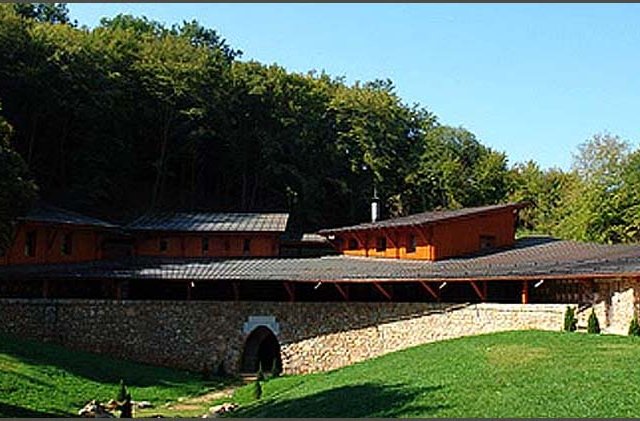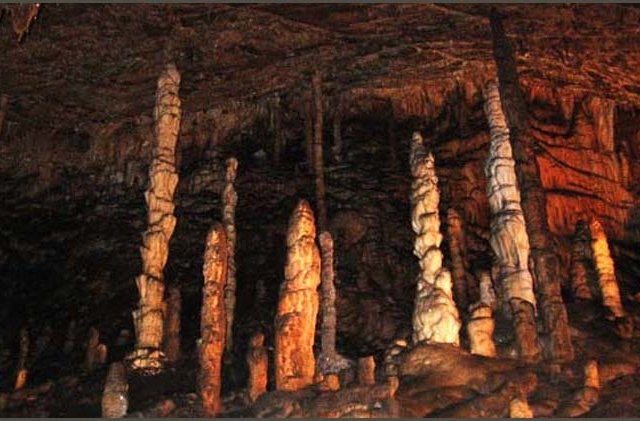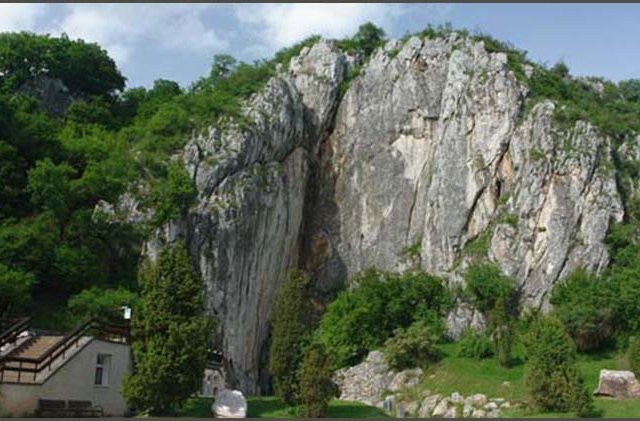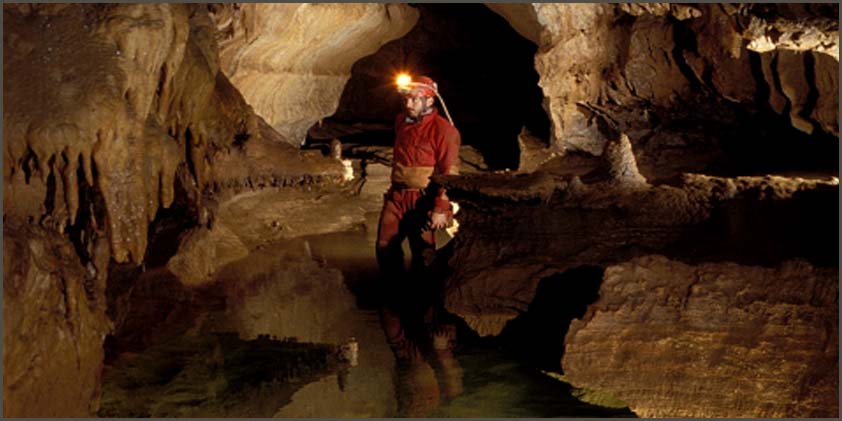
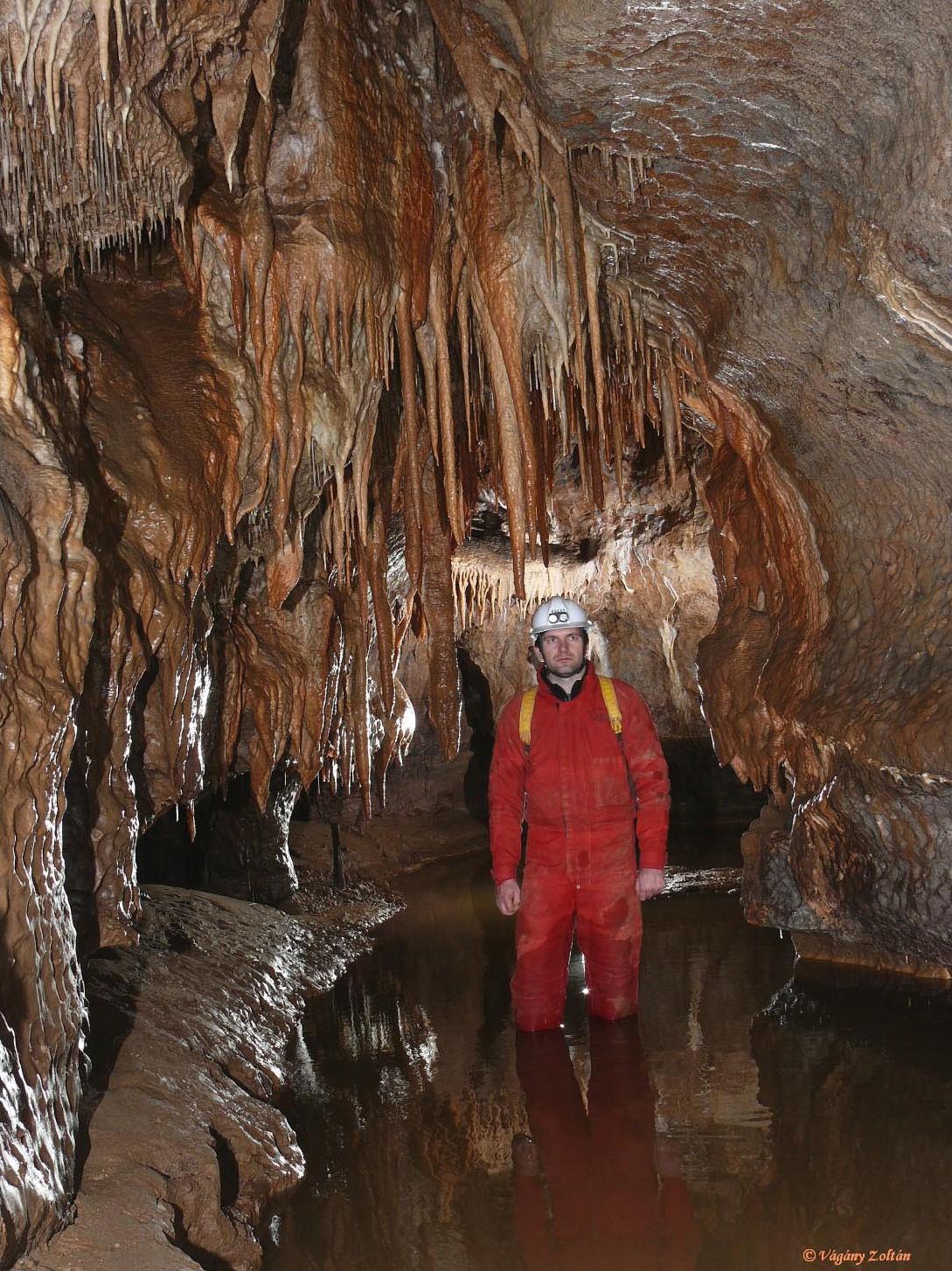
The Béke Cave (Peace Cave) is the fifth longest underground system in Hungary, and the second longest one in the Aggtelek Karst. It has three artificial entrances: the Discovery Branch at Aggtelek has been closed due to nature protection considerations and safety reasons; the artificial main entrance was opened in 1954 in Aggtelek (south of Szár Mountain) and is still in use; and the third access was established in 1964 near Jósvafő. The cave and its 643ha (2.5 square miles) water catchment area came under protection in the year of its discovery, and deserves strict protection for its outstanding speleological features.
Exploration
Water tracing experiments predicted the existence of a hydro-biologically separate cave from the Baradla Cave. This hypothesis was proven in 1952 when a speleologist group led by László Jakucs discovered the Peace Cave when they succeeded navigating the cave through the Discovery Branch. Thanks to the photos published by Ferenc Hollenter and István Markó, the conditions of the newly discovered cave have been recorded and documented. The main tunnel was totally explored by the end of the 1950’s, and following decades were dedicated to discovering the additional side-branches. Chimneys in the ceiling showing similarities to sinkholes were climbed by a group led by Márton Kucsera and Attila Nyerges in 1998-2000. The first detailed map was provided by László Jakucs, but lacked information on the Jósvafő exit. The main tunnel was only assessed again ten years later by Gábor Kőhalmy and Kálmán Somody, this time giving the necessary coordinates of the tunnel. Between 1990-1994, a more sophisticated and detailed 67-page 1:100 scale map was drawn by Judit Kisbán and Gábor Szunyogh.
The Natural Environment
The Peace Cave was mostly formed within Middle Triassic limestone (Wetterstein, Gutenstein or Steinalm), its active section exceeds 6400 m. The meandering Main Tunnel forms the backbone of the cave (4350 m along), and first-rate side branches (the 684 m long “Discovery” and the 438 m long “Snake”) and the decreasingly shortening and narrowing second-rate branches are connected to it just like limbs to a tree-trunk.
The Peace Cave was mostly formed within Middle Triassic limestone (Wetterstein, Gutenstein or Steinalm), its active section exceeds 6400 m. The meandering Main Tunnel forms the backbone of the cave (4350 m along), and first-rate side branches (the 684 m long “Discovery” and the 438 m long “Snake”) and the decreasingly shortening and narrowing second-rate branches are connected to it just like limbs to a tree-trunk.
The Main Tunnel can be divided into three parts. The upper section strongly zigzags, is moderately rich in dripstones and is usually dry (carrying water only during very rainy seasons). The middle part is extremely rich in speleothems. The Komlós Spring is usually active there, and dries up only during particularly dry periods. The tunnels in the lower parts of the cave are almost always covered by water to a depth fluctuating between 0.5-1 m. However, at the "Scalloped Lake" it reaches 2m in depth. Large areas in the lower regions are constantly perpetually covered by water, producing a unique ambiance there: the dripstones and walls are always shining because of the precipitating water. Its orange, red and white cascades are crystal-clear, while the halls echo to the sounds of its waterfalls.
The size of the cave varies, but the average width and height is 4-7 m in the upper section, 5.5-10 m in the middle, and 3.7-4 m in the lower part. The biggest hall in the cave is the "Giant’s Hall," measuring 60 m long, 20 m wide and 18 m in height.
The tunnels of the Peace Cave are almost intact but one must take into account some cave-ins along the Discovery Tunnel’s streambed. Notably, signifigant movement has often been detected along the “Recsego” section, making it difficult to traverse. However, the so-called“Small-” and “Big Collapses” are stabile. One should count on falling rocks along the entire length of the “Discovery” through the end of the “Pig Bath.” Sections amounting to several hundred meters (especially in the upper part of the “Discovery” and the “Main” branch) consist of a series of meandering bends. The meandering migration of the Komlós has left easily trackable deposits from the constant erosion process. It has left behind not a record of destruction, but of different stages of creation and development. Moreover, the most striking result of the meandering is that the linkages between the different levels of the cave have shifted.
Hydrological Characteristics
The Peace Cave is an active type of cave. The water network is the backbone of 7.7 m average gradient Komlós Stream. The Komlós’ spring is located in a 60 m long, impenetrably narrow tunnel. Channels act much as drinking water wells, collecting leaking water along the Great Valley Karst. The Komlós is fed by discharges along the "Snake" and "Discovery" branches, as well as by ten springs within the cave. Springs in the side-branches support this main water-flow, the most active of them being the one in the "Bath Siphon," carrying water even during the driest periods when other water sources have dried up. The cave’s hydrological activity can be attributed to the fact that the more than 400 cascades feed into the Komlós, therefore providing both a continuous water-supply and prompting the formation of tufa. The tufa dams have created a chain of 123 basins. During the dry season, the Komlós is quiet, but during heavy rainfall and runoff from snow melt, a thundering waterfall is born. The water exits the cave through the “Giant’s Hall” and breaks to the surface in Jósvafő. During times of extraordinary flooding, even the “Giant’s Hall” and the Sanatorium section can be inundated.
An extraordinary karst phenomenon can be observed in the “Head-Knocking Siphon” part of the cave: so-called “catavothras,” subterranean channels behaving alternately as a spring and as a sinkhole.The Komlós’ mean discharge is 0.85 m3/minute, but varies widely. The yield from the spring has been measured to produce a minimum of 0.012 m3/minute, and a maximum of 27430 m3/minute. Very rarely, following a prolonged drought for example, the cave’s immersed siphons dry out completely. However, water levels during floods can exceed 5-10 cm above the level of the rims of tufa dams.
Geological Treasures
Despite its speleological importance, relatively little research has been conducted in the Peace Cave. The meandering streambed, along with siphons, are characteristic of this cave. Interesting speleothems such as stone-mushrooms, scallops/crests, chambered stones and timber-like stalagmite columns rule this underground world. This cave system hosts one of the richest speleothem accumulations in Hungary. Curiosities like cave eggs, carnation calcite, pisolite or pea-stone, cover-pea stones and helictites abundantly decorate this system.
Despite its speleological importance, relatively little research has been conducted in the Peace Cave. The meandering streambed, along with siphons, are characteristic of this cave. Interesting speleothems such as stone-mushrooms, scallops/crests, chambered stones and timber-like stalagmite columns rule this underground world. This cave system hosts one of the richest speleothem accumulations in Hungary. Curiosities like cave eggs, carnation calcite, pisolite or pea-stone, cover-pea stones and helictites abundantly decorate this system.
The Peace Cave is positively rich in various forms of geologic formations. For example, 30-60 cm high “stone mushrooms,” frequently occurring “knife blades” projecting from the sides of the course, “reminder crests” otherwise known as “harikiri rocks,” ear-shaped rocks at several points along the walls, delved out cavities, and frequent several meter high pillars. It is worth mentioning that rocks that have fallen into the creek bed (moveable and balancing stones) obstructing the water flow in some places. The Komlós has not eroded a new bed for itself yet, meaning that numerous obstacles continue to be present. Rather, the stream has kept to its original channel and has been eroding the underside of the blockages in order to maintain its course. Hence, while the obstructions do not rest entirely on the stream bed, they still make contact and rest their weight across some points of contact.
The system is one of the wealthiest stalactite caves in Hungary. The huge stalagmites may be compared to living things - they are are in a continuous state of development. The richness of color and form provide a wide variety of examples, described and separated by type in associated expert literature. The overall condition of the cave is good. Traces of damage are evident in only relatively few places. The development of stalactites has affected the Komlós’ water levels in a special way - the multiplication of tufa dams has caused water levels to continue to rise. On the one hand, when the water level reaches the dripstones, their further growth is hampered. On the other hand, this process also hides rich mineral precipitates such as carnation calcites, pea-stones and stalactite-collars from sight, which only reappear to decorate the cave when water levels decline.
Another interesting spectacle is the common presence of rounded 1-2 cm2 tufa manifestations stacked like pillows in shallow pools (particularly at the entrances to the “Grand Tufa” and “Snake Branch”).
The formation of side branches is thanks to damage caused by the flow of calcium canbonate-rich supersaturated water. Also thanks to the loose structure, the Main Branch’s bed is largely covered with 2-4 cm diameter travertine spheres, or “cave eggs.” The walls at mid-stream are evenly covered with pea stone-like formations on one side, situated in an almost straight line, cover-pea stones originating from the aerosol content of the air, and in some places, large deposits of enriched heliktit. Higher reaches of the Main Branch’s upper route are marked by clay and clay pyramids, diverse grooves and wells.
Fauna
Research into the fauna of the Peace Cave has only begun recently. Unfortunately, István Kovács’s previous investigations were not sufficiently extensive or thorough enough. Consequently, literature about the cave’s fauna seems poor in comparison to information about the Freedom Cave. Much better results were achieved by Jenő Ponyi, who with Árpád Berczik during a hydrobiologic collecting trip (1954-55), found specimens of Bathynella hungarica and Troglochaetus beranecki.
Very little organic debris reaches the the bottom of the cave through the narrow gully. Such geology does not typically include a large number of unique terrestrial species. Various spiders, diptera (flies) and lepidoptera (moths and butterflies) have been discovered in these interstitial habitats. Compared to the seemingly sparse fauna, small predators such as the Troglochaetus beraneckii (a type of ancient worm), the Batynelly hungarica (a crustacean), Duvalius hungaricus (a beetle of the Carabidae family), Trechus austriacus (a kind of beetle), Eukoenenia austriaca and Duvalius hungaricus are common. These last three were not chanced upon by Kovács, even though they were present at the time. The Mesoniscus graniger (a kind of woodlice) population is much sparser than in the Baradla Cave, whereas the Niphargus aggtelekiensis (a freshwater amphipod) is usually found at the bottom of the muddy waters. During winter, signifigant bat populations roost (Rhinolophus ferrum-equinum and hipposideros, Myotis blythi, M. emarginatus, M. daubentoni, M. myotis, Plecotus spp.), especially in the “Discovery” section and cooler regions near the surface.
Medicinal Benefits
The healing properties of the air in the Peace Cave were recognised shortly after its discovery and this cave was declared as a cave with healing properties in 1965 – the first of its kind in Hungary. Unfortunately therapies conducted in the “Giant’s Hall” near Jósvafő have been interrupted in recent years and there seems little hope for their resumption.
The healing properties of the air in the Peace Cave were recognised shortly after its discovery and this cave was declared as a cave with healing properties in 1965 – the first of its kind in Hungary. Unfortunately therapies conducted in the “Giant’s Hall” near Jósvafő have been interrupted in recent years and there seems little hope for their resumption.
Research
Relatively little speological research has been made of the Peace Cave. Notably, hydrological research was conducted by László Jakucs and László Zámbó, Martin Kirchknopf made therapeutic trials, and István Kovács, Gábor Salamon and János Vágvölgyi made biological observations. Jakucs investigated the chemical composition of the Komlós and introduced the concept of the A-type and B-type floods. In addition, he demonstrated the important role erosion plays in the Aggtelek caves, and established a classification system for the dripstones based on colour and spatial variability. László Zámbó developed a full-scale complex and comprehensive descending measurement system that has built up a continuous recording of the physical and chemical parameters of water infiltration through the ceilings of the karst caverns.

